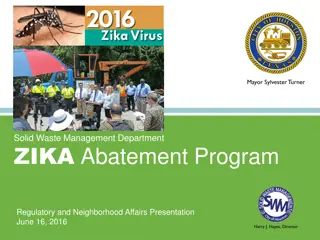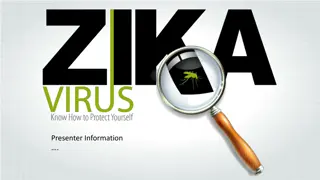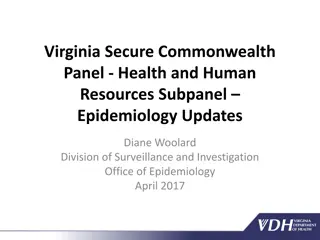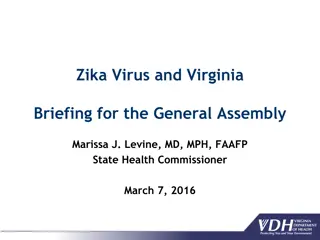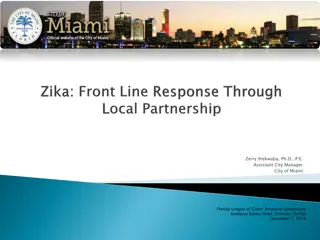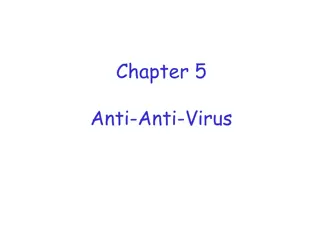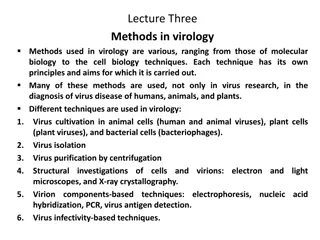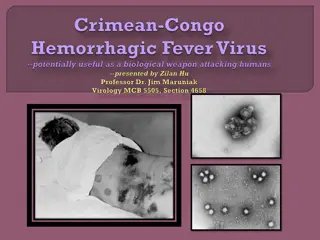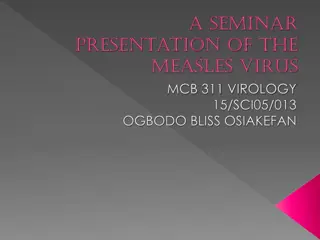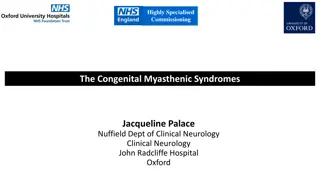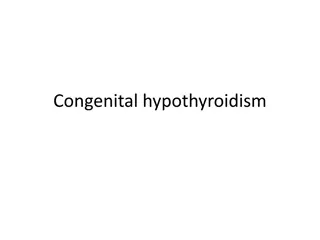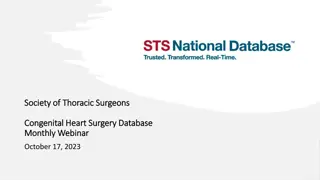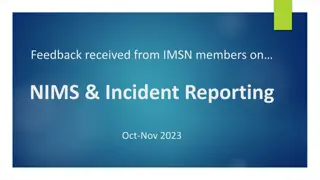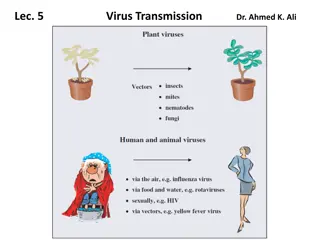Understanding Congenital Zika Virus Infection Evaluation and Reporting
This module provides comprehensive information on evaluating, testing, and reporting cases of congenital Zika virus infection. Learners will gain insights into guidelines, case definitions, and the importance of accurate reporting for better surveillance. Access to updated resources and the impact on Zika surveillance is also discussed. The module covers topics like initial evaluation, testing infants, case types, and reporting guidelines, emphasizing the critical role of prompt evaluation and testing for newborns with suspected congenital Zika infection.
Download Presentation

Please find below an Image/Link to download the presentation.
The content on the website is provided AS IS for your information and personal use only. It may not be sold, licensed, or shared on other websites without obtaining consent from the author. Download presentation by click this link. If you encounter any issues during the download, it is possible that the publisher has removed the file from their server.
E N D
Presentation Transcript
Evaluating, Testing, and Reporting Cases of Congenital Zika Virus Infection Module 4 March 2020
Evidence on Zika virus infection and its consequences continues to evolve. Please consult the WHO, PAHO, and U.S. CDC websites below for the most up-to-date and thorough information on prevention, diagnosis, and management of Zika virus infection and its consequences. WHO: https://www.who.int/emergencies/diseases/zika/en/ PAHO:https://www.paho.org/hq/index.php?option=com_content&vie w=article&id=11585:zika-virus-infection&Itemid=41688&lang=en CDC: https://www.cdc.gov/zika/index.html
Module Introduction Appropriate evaluation and testing helps to ensure that children affected by congenital Zika virus infection receive the care they need. Accurate reporting contributes to better Zika surveillance. Image source: Jhpiego, 2018
Module Objectives At the end of this module, learners will be able to: Describe existing guidelines for evaluating and testing congenital Zika virus infection Identify resources for locating updated evaluation and management guidance Recognize different case types associated with Zika virus infection during pregnancy with or without CZS Explain how reporting cases impacts Zika surveillance
Module Topics 1. Importance of initial evaluation and testing of newborns for congenital Zika virus infection 2. Evaluating infants for congenital Zika virus infection 3. Testing infants for congenital Zika virus infection 4. Case definitions for congenital Zika syndrome 5. Reporting cases of congenital Zika syndrome
Why are Initial Evaluation and Testing Important? Initial evaluation and testing of newborns with suspected congenital Zika infection allows: Confirmation of diagnosis Initiation of appropriate care, including specialized care and referral for additional follow-up as needed Image source: Jhpiego, 2018 Anticipatory counseling to families of affected infants
Case Definitions for Zika-Virus-Associated Pregnancy Loss Suspected Zika-Virus- Associated Pregnancy Loss or Stillbirth Confirmed Zika-Virus- Associated Pregnancy Loss or Stillbirth Pregnancy loss or stillbirth in a woman, who during her pregnancy presented rash AND resided in or travelled to an area where Zika virus vectors were present; OR had unprotected sex during pregnancy with a partner who resided in or travelled to an area where Zika virus vectors were present. Suspected case in which specimens from either the mother (blood or urine) or the pregnancy loss/stillbirth are laboratory-positive for Zika virus. Miscarriages and fetal deaths due to congenital Zika virus infection may be misidentified. These case definitions provided by WHO/PAHO should be used for determining whether a miscarriage or fetal death is associated with Zika infection. Source: PAHO case definition, 2016
Knowledge Check One reason for the underreporting of CZS- confirmed cases is that pregnancy losses and stillbirths due to congenital Zika virus infection may be misidentified. True False
Knowledge Check Answer True. One reason for underreporting of CZS-confirmed cases is that pregnancy losses and stillbirths due to congenital Zika virus infection may be misidentified.
Selected Evaluation and Management Guidelines PAHO and WHO Guidelines for surveillance of Zika virus disease and its complications http://iris.paho.org/xmlui/handle/123456789/28405?locale-attribute=en WHO Toolkit: Evaluation and Management of Affected Children http://www.who.int/mental_health/neurology/zika_toolkit/en/ Additional guidance is available from US CDC but countries should consider local capacity when reviewing CDC guidelines. CDC https://www.cdc.gov/zika/hc-providers/infants-children/evaluation-testing.html
Consider Maternal History When Evaluating Infants Health providers should check: Family history of congenital malformations Antenatal clinical history: Maternal Zika virus infection Recent sexual partner infection or exposure to Zika virus Exposure to other potential teratogens Conditions in pregnancy TORCH serology (toxoplasma, rubella, cytomegalovirus (CMV), herpes simplex virus, and syphilis)
Comprehensive Assessment Physical assessment of infant Measurement of head circumference (HC) Assessment for neurological abnormalities Diagnostic testing (as available) Other potential causes of microcephaly and anomalies, e.g., alcohol, genetic disorders. Gestational age, which is important for neurodevelopmental evaluation Validated scale or by examining features, e.g., skin appearance, lens vascularization, breast tissue, ear cartilage, external genitalia, and plantar surface. Sources: WHO Toolkit and Integrated management of childhood illness,
Look for These Concerns on Evaluation Head too small relative to face or body Abnormal tone (e.g., too stiff/floppy) Seizures Abnormal vision exam, hearing screening Difficulty feeding Contractures of limbs Abnormal neuroimaging Signs of hydrocephalus (e.g., head circumference 2SD, excessively sleepy, bulging fontanel, etc.) Image source: Jhpiego, 2018
ALL Infants Should Have Head Circumference Measured Microcephaly is defined as having a head circumference (HC) <-2 standard deviations from the reference population average as standardized for age and sex. Image source: WHO Toolkit, 2017 Source: PAHO Surveillance Manual
Evaluation of Microcephaly in Premature and Full-term Newborns International Fetal and Newborn Growth Consortium for the 21st Century (Intergrowth-21st) includes standards that provide greater precision for evaluation of microcephaly in premature and full-term newborns. Correct use requires having reliable data on gestational age (from first-trimester ultrasound or date of last menstrual period). Source: PAHO Surveillance Manual
Evaluation of Microcephaly When Gestational Age at Birth is Unknown In full-term newborns for whom reliable information on gestational age at birth is unavailable, use growth standards from WHO Multicentre Growth Reference Study. To measure HC, when possible, use measuring tape developed by the Latin American Center for Perinatology (CLAP). Source: PAHO Surveillance Manual
Common Dysmorphic Features Associated With Congenital Zika Virus Infection Craniofacial disproportion Epicanthic folds Retrognathia Redundant scalp skin Abnormal skull shape, including closed fontanelles and overlapped sutures Micro/anophthalmia, cataracts Limb contractures Multiple dimples Multiple arthrogryposis Arthrogryposis Image source: WHO Toolkit, 2017
Knowledge Check Microcephaly can be defined as having a head circumference (HC) <-2 standard deviations from the reference population average as standardized for _______ and _______. Age and weight Age and sex Height and sex 22
Knowledge Check Answer Microcephaly can be defined as having a head circumference (HC) <-2 standard deviations from the reference population average as standardized for age and sex. 23
Which Infants Should be Tested? Providers should follow local guidance/capacity for laboratory testing of infants. Consider testing neonates with severe microcephaly who meet either of the following criteria: Born to mothers residing in areas of Zika transmission Evidence of Zika infection during pregnancy (either clinical or laboratory) and/or fetal imaging concerning for congenital Zika infection.
Recommended Testing If capacity allows, perform laboratory testing for ZIKV (RT-PCR in blood or urine; IgM in blood), plus: Neuroimaging (CT/MRI) TORCH screening If results not available before discharge, presume infants have congenital Zika infection until results are available. Infants with confirmed and probable Zika infection should be managed in the same way, according to guidance. Image source: Jhpiego, 2018 Source: WHO Toolkit, 2017
WHO/PAHO Case Definitions for CZS Suspected CZS Case Possible CZS Case Newborn with microcephaly or other CNS anomaly, Confirmed CZS Case Newborn with suspicion criteria, with laboratory test confirming recent infection Newborn with suspicion criteria, who has intracranial anomalies by imaging, or whose mother has a rash during pregnancy born to mother living in a Zika area, or who had unprotected sex with a partner from a Zika area during pregnancy
WHO/PAHO Case Definitions for Vertical Transmission of Zika Virus Without CZS CASE DEFINITIONS Suspected vertical transmission (without CZS) Probable case of vertical transmission (without CZS) Confirmed case of vertical transmission (without CZS) Live newborn of any gestational age who has not met the criteria for a suspected case of congenital syndrome associated with Zika virus AND whose mother had a suspected, probable or confirmed case of Zika infection during pregnancy. Live newborn who meets the criteria for suspected vertical transmission in whom Zika IgM antibodies are detected by ELISA or virus RNA is detected by RT-PCR in a umbilical cord blood sample. Live newborn who meets the criteria for suspected vertical transmission in whom anti-Zika IgM* is detected by ELISA in a serum sample of the newborn. * When only PCR is available and it is positive, follow-up serology is advised because viral detection could be from perinatal rather than vertical transmission. Source: PAHO case definition, 2016
Knowledge Check Case description: Newborn meeting criteria for suspected CZS, with laboratory test confirming recent infection. According to WHO/PAHO case definitions, what type of case fits the description above? Select the best choice. Suspected case of CZS Possible case of CZS Confirmed case of CZS
Knowledge Check Answer Case description: Newborn meeting criteria for suspected CZS, with laboratory test confirming recent infection. A live newborn who meets criteria for a suspected case of congenital syndrome associated with Zika virus AND Zika virus infection was detected in specimens of the newborn, regardless of detection of other pathogens, is considered a confirmed case of CZS.
Reporting Cases of CZS Health providers should report cases of CZS according to local standards and guidelines. Countries are only reporting confirmed CZS cases to PAHO. Due to limitations in laboratory capacity, confirmed cases likely do not represent the total number of true cases of CZS. More accurate reporting of pregnancy losses and stillbirths due to congenital Zika infection can contribute to better Zika surveillance (likely underreported). Image source: Jhpiego, 2018
Summary 1. Consider maternal history, CZS signs when evaluating infants. 2. Infants born in areas of Zika transmission or to mothers with suspected, probable, or confirmed Zika infection should have comprehensive assessment including head circumference, neurological assessment, and diagnostic testing as available. 3. Test neonates with severe microcephaly and either criterion: Born to mothers residing in areas of Zika transmission Zika during pregnancy (clinical or lab) and/or fetal imaging 4. Intergrowth-21st: best evaluation of microcephaly in premature and full-term newborns if GA is known. 5. Check WHO and PAHO for updated guidance. 6. Due to limitations in laboratory capacity, confirmed cases likely do not represent total number of true cases of CZS.
Module Resources PAHO and WHO Guidelines for surveillance of Zika virus disease and its complications http://iris.paho.org/xmlui/handle/123456789/28405?locale-attribute=en WHO Toolkit for the Care And Support Of People Affected by Complications Associated with Zika Virus www.who.int/mental_health/neurology/zika_toolkit/en The WHO Child Growth Standards http://www.who.int/childgrowth/standards/en/ INTERGROWTH Standards and Tools https://intergrowth21.tghn.org/standards-tools/ CDC Evaluation for Infants With Possible Congenital Zika Virus Infection https://www.cdc.gov/pregnancy/zika/testing-follow-up/documents/pediatric-evaluation- follow-up-tool.pdf 32
References Adebanjo T, Godfred-Cato S, Viens L, et al. Update: Interim Guidance for the Diagnosis, Evaluation, and Management of Infants with Possible Congenital Zika Virus Infection United States, October 2017. MMWR Morb Mortal Wkly Rep 2017;66:1089 1099. DOI:http://dx.doi.org/10.15585/mmwr.mm6641a1. CDC. Zika and pregnancy: Evaluation and testing. Retrieved on 05/01/2019 from https://www.cdc.gov/pregnancy/zika/testing-follow-up/evaluation-testing.html Nielsen-Saines, K. Congenital Zika virus infection: Clinical features, evaluation, and management of the neonate. Retrieved on 11/27/2018 from https://www.uptodate.com/contents/congenital-zika-virus-infection- clinical-features-evaluation-and-management-of-the-neonate. PAHO and WHO Guidelines for surveillance of Zika virus disease and its complications. Retrieved on 05/01/19 from http://iris.paho.org/xmlui/handle/123456789/28405?locale-attribute=en PAHO. Zika resources: Case definitions. 4/1/2016. Retrieved on 11/27/2018 from http://www.paho.org/hq/index.php?option=com_content&view=article&id=11117:2015-zika-case-definitions- &Itemid=41532&lang=es. WHO. Integrated management of childhood illness. Geneva: World Health Organization; 2017. Retrieved on 05/01/2019 from: http://www.who.int/maternal_child_adolescent/topics/child/imci/en/ WHO Toolkit: Evaluation and Management of Affected Children. Retrieved on 05/01/2019 from: http://www.who.int/mental_health/neurology/zika_toolkit/en/
Acknowledgements MCSP is a global USAID program to introduce and support high-impact health interventions in 25 priority countries to help prevent child and maternal deaths. MCSP supports programming in maternal, newborn, and child health, immunization, family planning and reproductive health, nutrition, health systems strengthening, water/sanitation/hygiene, malaria, prevention of mother-to-child transmission of HIV, and pediatric HIV care and treatment. MCSP will tackle these issues through approaches that also focus on household and community mobilization, gender integration, and digital health, among others. This learning module is made possible by the generous support of the American people through the United States Agency for International Development (USAID) under the terms of the Cooperative Agreement AID-OAA-A-14-00028. The contents are the responsibility of the Maternal and Child Survival Program and do not necessarily reflect the views of USAID or the United States Government.


